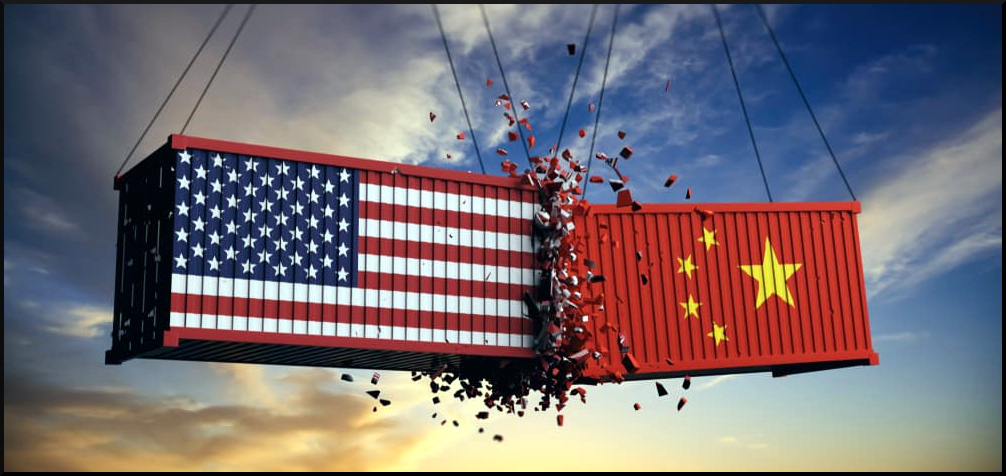By posted to Workers World on August 14, 2019
During the Cold War and the struggle that put the USSR and China on one side and imperialism, headed by Washington, on the other, revolutionaries used to characterize the conflict as a class war between two irreconcilable social systems.
On one side was the socialist camp, based upon socialized property, economic planning for human need and the government monopoly of foreign trade. On the other was capitalism, a system of production for profit.
That the two systems were irreconcilable was at the bottom of the conflict dubbed the Cold War. In light of the current sharpening economic, diplomatic, political and military conflict between U.S. imperialism and the People’s Republic of China (PRC), it is time to revive the concepts that were applied during the height of the Cold War.
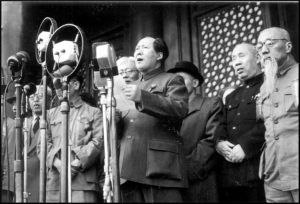
Of course, it is necessary to make modifications in these formulations with respect to socialism in China, with its mix of controlled capitalism and guided socialism. Nevertheless, the conflict between imperialist capitalism, headed by Washington, Wall Street and the Pentagon, and the Chinese socialist economic system, with state-owned industry at its core and planned economic guidance, is becoming much sharper, and imperialism is growing more openly hostile.
U.S. imperialism’s long-standing effort to overthrow socialism in China, Chinese capitalism notwithstanding, has been concealed beneath sugary bourgeois phrases about so-called “common interests” and “economic collaboration.” But this kind of talk is coming to an end.
Washington’s first campaign to overthrow China — 1949-1975
This struggle has been ongoing since 1949, when the Chinese Red Army drove U.S. puppet Chiang Kai-shek and his Nationalist army from the mainland as it retreated to Taiwan under the protection of the Pentagon.
The conflict continued through the Korean War, when Gen. Douglas MacArthur and the U.S. high command drove U.S. troops to the Chinese border and threatened atomic war. Only the defeat of the U.S. military by the heroic Korean people, under the leadership of Kim Il Sung and with the aid of the Chinese Red Army, stopped a U.S. invasion of China.
The struggle further continued with the U.S. war against Vietnam, whose strategic goal was to overthrow the socialist government of Vietnam in the north and drive to the border of China to complete the military encirclement of the PRC. Only the world-historic efforts of the Vietnamese people under the leadership of Ho Chi Minh stopped the Pentagon in its tracks.
Pentagon’s plans for military conquest failed
With the rise of Deng Xiaoping and the opening up of China to foreign investment, beginning in December 1978, Wall Street began to reevaluate its strategy. The U.S. ruling class began to take advantage of the opening up of China to foreign investment as well as the permission for private capitalism to function, which could both enrich U.S. corporations in the massive Chinese market and at the same time penetrate the Chinese economy with a long-range view to overturning socialism.
U.S. multinational corporations set up operations in China, hiring millions of low-wage Chinese workers, who flocked to the coastal cities from the rural areas. These operations were part of a broader effort by the U.S. capitalists to set up low-wage global supply chains that integrated the Chinese economy into the world capitalist market.
The U.S.’s recent sharp turn aimed at breaking up this economic integration with the Chinese economy, including the witch hunt against Chinese scientists and the U.S. Navy’s aggressive behavior in the South China Sea (called the Eastern Sea by Vietnam), is an admission that the economic phase of the U.S. attempt to bring counterrevolution to China has failed.
China is now a growing counterweight to Washington in international economics, high technology, diplomacy and regional military might in the Pacific, which the Pentagon has always considered to be a “U.S. lake” ruled by the Seventh Fleet.
The attack on Huawei
A dramatic illustration of the developing antagonisms is the way the U.S. had Canada arrest Meng Wanzhou, the deputy chairwoman and chief financial officer of Huawei Technologies, for supposed violations of U.S. sanctions against Iran — an outrageous example of imperialism exercising extraterritoriality. The Trump administration has also leveled sanctions against Huawei, the world’s largest supplier of high-tech operating systems in the world.
Huawei employs 180,000 workers and is the second-largest cell phone manufacturer in the world after the south Korean-based Samsung. The sanctions are part of the U.S. campaign to stifle China’s development of the latest version of data-transmission technology known as fifth generation, or 5G.
The Trump administration has barred U.S. companies from selling supplies to Huawei, which has been using Google’s Android operating system for its equipment and Microsoft for its laptop products − both U.S.-based companies. Huawei is contesting the U.S. ban in court.
Meanwhile, as a backup plan in case Washington bans all access to Android and Microsoft, Huawei has quietly spent years building up an operating system of its own. Huawei developed its alternative operating system after a 2012 finding by Washington that Huawei and ZTE, another Chinese giant cell phone maker, were in criminal violation of U.S. “national security.” ZTE was forced to shut down for four months. (South Asia Morning Post, March 24)
But the conflict is about more than just Huawei and ZTE.
New ‘red scare’ in Washington
The New York Times of July 20 carried a front-page article entitled “The New Red Scare in Washington.” A few excerpts give the flavor:
“In a ballroom across from the Capitol building, an unlikely group of military hawks, populist crusaders, Chinese Muslim freedom fighters and followers of the Falun Gong has been meeting to warn anyone who will listen that China poses an existential threat to the United States that will not end until the Communist Party is overthrown.
“If the warnings sound straight out of the Cold War, they are. The Committee on the Present Danger, a long-defunct group that campaigned against the dangers of the Soviet Union in the 1970s and 1980s, has recently been revived with the help of Stephen K. Bannon, the president’s former chief strategist, to warn against the dangers of China.
“Once dismissed as xenophobes and fringe elements, the group’s members are finding their views increasingly embraced in President Trump’s Washington, where skepticism and mistrust of China have taken hold. Fear of China has spread across the government, from the White House to Congress to federal agencies….”
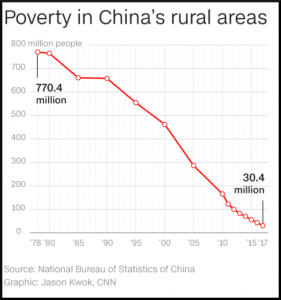 The Trump administration has opened up a tariff war against the PRC, imposing a 25-percent tariff on $250 billion worth of Chinese exports and threatening tariffs on another $300 billion. But there is much more to Washington’s campaign than just tariffs.
The Trump administration has opened up a tariff war against the PRC, imposing a 25-percent tariff on $250 billion worth of Chinese exports and threatening tariffs on another $300 billion. But there is much more to Washington’s campaign than just tariffs.
The FBI and officials from the National Security Council have been conducting a witch hunt, continues the Times article,
“particularly at universities and research institutions. Officials from the FBI and the National Security Council have been dispatched to Ivy League universities to warn administrators to be vigilant against Chinese students….”
According to the Times, there are concerns that this witch hunt
“is stoking a new red scare, fueling discrimination against students, scientists and companies with ties to China and risking the collapse of a fraught but deeply enmeshed trade relationship between the world’s two largest economies.” (New York Times, July 20)
FBI criminalizes cancer research
According to a major article in the June 13 Bloomberg News,
“Ways of working that have long been encouraged by the NIH [National Institutes of Health] and many research institutions, particularly MD Anderson [a major cancer treatment center and research institute in Houston], are now quasi-criminalized, with FBI agents reading private emails, stopping Chinese scientists at airports, and visiting people’s homes to ask about their loyalty.
“Xifeng Wu, who has been investigated by the FBI, joined MD Anderson while in graduate school and gained renown for creating several so-called study cohorts with data amassed from hundreds of thousands of patients in Asia and the U.S. The cohorts, which combine patient histories with personal biomarkers such as DNA characteristics and treatment descriptions, outcomes, and even lifestyle habits, are a gold mine for researchers.
“She was branded an oncological double agent.”
The underlying accusation against Chinese scientists in the U.S. is that their research can lead to patentable medicines or cures, which in turn can be sold at enormous profits.
The Bloomberg article continues,
“In recent decades, cancer research has become increasingly globalized, with scientists around the world pooling data and ideas to jointly study a disease that kills almost 10 million people a year. International collaborations are an intrinsic part of the U.S. National Cancer Institute’s Moonshot program, the government’s $1 billion blitz to double the pace of treatment discoveries by 2022. One of the program’s tag lines is: ‘Cancer knows no borders.’
“Except, it turns out, the borders around China. In January, Wu, an award-winning epidemiologist and naturalized American citizen, quietly stepped down as director of the Center for Public Health and Translational Genomics at the University of Texas MD Anderson Cancer Center after a three-month investigation into her professional ties in China. Wu’s resignation, and the departures in recent months of three other top Chinese-American scientists from Houston-based MD Anderson, stem from a Trump administration drive to counter Chinese influence at U.S. research institutions. … The collateral effect, however, is to stymie basic science, the foundational research that underlies new medical treatments. Everything is commodified in the economic cold war with China, including the struggle to find a cure for cancer.”
Big surprise. A world-famous Chinese epidemiologist, trying to find a cure for cancer, collaborates with scientists in China!
Looking for ‘reformers’ and counterrevolution
For decades the Chinese Communist Party has had changes of leadership every five years. These changes have been stable and managed peacefully. With each changeover, so-called “China experts” in the State Department, in Washington think tanks and in U.S. universities have predicted the coming to power of a new “reformist” wing that will deepen capitalist reforms and lay the basis for an eventual full-scale capitalist counterrevolution.
To be sure, there has been a steady erosion of China’s socialist institutions. The “iron rice bowl” which guaranteed a living to Chinese workers has been eliminated in private enterprises. Numerous state factories and enterprises have been sold off to the detriment of the workers, and in the rural areas land was decollectivized.
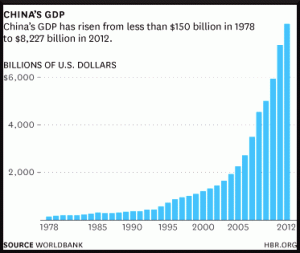 One of the biggest setbacks for socialism in China, and one which truly gladdened the hearts of the prophets of counterrevolution, was the decision by the Jiang Xemin CCP leadership to allow capitalists into the Chinese Communist Party in 2001.
One of the biggest setbacks for socialism in China, and one which truly gladdened the hearts of the prophets of counterrevolution, was the decision by the Jiang Xemin CCP leadership to allow capitalists into the Chinese Communist Party in 2001.
As the New York Times wrote at the time, “This decision raises the possibility of Communists co-opting capitalists — or of capitalists co-opting the party.” (New York Times, Aug. 13, 2001) It is the latter part that the capitalist class has been looking forward to and striving for with fervent anticipation for almost four decades.
But, on balance, this capitalist takeover has not materialized. Chinese socialism, despite the capitalist inroads into the economy, has proved far more durable than Washington ever imagined.
And, under the Xi Jinping leadership, the counterrevolution seems to be getting further and further away. It is not that Xi Jinping has become a revolutionary internationalist and a champion of proletarian control. But it has become apparent that China’s status in the world is completely connected to its social and economic planning.
China’s planning and state enterprises overcame 2007-2009 world capitalist crisis
Without state planning in the economy, China might have been dragged down by the 2007-2009 economic crisis in the capitalist world. In June 2013 this author wrote an article entitled, “Marxism and the Social Character of China.” Here are some excerpts:
“More than 20 million Chinese workers lost their jobs in a very short time. So what did the Chinese government do?”
The article quoted Nicholas Lardy, a bourgeois China expert from the prestigious Peterson Institute for International Economics and no friend of China. (The full article by Lardy can be found in “Sustaining China’s Economic Growth after the Global Financial Crisis,” Kindle Locations 664-666, Peterson Institute for International Economics.)
Lardy described how “consumption in China actually grew during the crisis of 2008-09, wages went up, and the government created enough jobs to compensate for the layoffs caused by the global crisis,” this author’s emphasis.
Lardy continued:
“In a year in which GDP expansion [in China] was the slowest in almost a decade, how could consumption growth in 2009 have been so strong in relative terms? How could this happen at a time when employment in export-oriented industries was collapsing, with a survey conducted by the Ministry of Agriculture reporting the loss of 20 million jobs in export manufacturing centers along the southeast coast, notably in Guangdong Province? The relatively strong growth of consumption in 2009 is explained by several factors.
“First, the boom in investment, particularly in construction activities, appears to have generated additional employment sufficient to offset a very large portion of the job losses in the export sector. For the year as a whole the Chinese economy created 11.02 million jobs in urban areas, very nearly matching the 11.13 million urban jobs created in 2008.
“Second, while the growth of employment slowed slightly, wages continued to rise. In nominal terms wages in the formal sector rose 12 percent, a few percentage points below the average of the previous five years (National Bureau of Statistics of China 2010f, 131). In real terms the increase was almost 13 percent.
“Third, the government continued its programs of increasing payments to those drawing pensions and raising transfer payments to China’s lowest-income residents. Monthly pension payments for enterprise retirees increased by RMB120, or 10 percent, in January 2009, substantially more than the 5.9 percent increase in consumer prices in 2008. This raised the total payments to retirees by about RMB75 billion. The Ministry of Civil Affairs raised transfer payments to about 70 million of China’s lowest-income citizens by a third, for an increase of RMB20 billion in 2009 (Ministry of Civil Affairs 2010).”
Lardy further explained that the Ministry of Railroads introduced eight specific plans, to be completed in 2020, to be implemented in the crisis.
According to Lardy, the World Bank called it “perhaps the biggest single planned program of passenger rail investment there has ever been in one country.” In addition, ultrahigh-voltage grid projects were undertaken, among other advances.
Socialist structures reversed collapse
So income went up, consumption went up and unemployment was overcome in China — all while the capitalist world was still mired in mass unemployment, austerity, recession, stagnation, slow growth and increasing poverty, and still is to a large extent.
The reversal of the effects of the crisis in China is the direct result of national planning, state-owned enterprises, state-owned banking and the policy decisions of the Chinese Communist Party.
There was a crisis in China, and it was caused by the world capitalist crisis. The question was which principle would prevail in the face of mass unemployment — the rational, humane principle of planning or the ruthless capitalist market. In China the planning principle, the conscious element, took precedence over the anarchy of production brought about by the laws of the market and the law of labor value in the capitalist countries.
Socialism and China’s standing in the world
China has lifted hundreds of millions of people out of poverty. According to a United Nations report, China alone is responsible for the global decline in poverty. China’s universities have graduated millions of engineers, scientists and technicians; its education system has allowed millions of peasants to enter the modern world.
Made in China 2025
In 2015 Xi Jingping and the Chinese CP leadership laid out the equivalent of a ten-year plan to take China to a higher level of technology and productivity in the struggle to modernize the country.
Xi announced a long-range industrial policy backed by hundreds of billions of dollars in both state and private investment to revitalize China. It is named Made in China 2025 or MIC25. It is an ambitious project requiring local, regional and national coordination and participation.
The Mercator Institute for Economics (MERICS) is one of the most authoritative German think tanks on China. It wrote a major report on MIC25 on Feb. 7. According to MERICS,
“The MIC25 program is here to stay and, just like the GDP targets of the past, represents the CCP’s official marching orders for an ambitious industrial upgrading. Capitalist economies around the globe will have to face this strategic offensive.
“The tables have already started to turn: Today, China is setting the pace in many emerging technologies – and watches as the world tries to keep pace.”
The MERICS report continues
“China has forged ahead in fields such as next-generation IT (companies like Huawei and ZTE are set to gain global dominance in the roll-out of 5G networks), high-speed railways and ultra-high voltage electricity transmissions. More than 530 smart manufacturing industrial parks have popped up in China. Many focus on big data (21 percent), new materials (17 percent) and cloud computing (13 percent). Recently, green manufacturing and the creation of an “Industrial Internet” were given special emphasis in policy documents, underpinning President Xi Jinping’s vision of creating an ‘ecological civilization’ that thrives on sustainable development.
“China has also secured a strong position in areas such as Artificial Intelligence (AI), new energy and intelligent connected vehicles….
“Chinese state-owned enterprises (SOEs) continue to play a critical role for the development of strategic industries and high-tech equipment associated with MIC25. In so-called key industries like telecommunications, ship building, aviation and high-speed railways, SOEs still have a revenue share of around 83 percent. In what the Chinese government has identified as pillar industries (for instance electronics, equipment manufacturing, or automotive) it amounts to 45 percent.”
Breakup of U.S.-China relationship inevitable
The tariff war between the U.S. and China has been going back and forth. It may or may not be resolved for now or may end up in a compromise. The Pentagon’s provocations in the South China Sea and the Pacific are unlikely to subside. The witch hunt against Chinese scientists is gaining momentum.
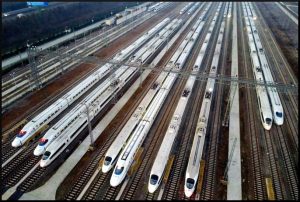
The U.S. has just appropriated $2.2 billion for arms to Taiwan. National Security Adviser and war-hawk John Bolton recently made a trip to Taiwan. The president of Taiwan, Tsai Ing-wen, made a recent stopover in the U.S. on the way to the Caribbean and is scheduled to make another one on the way back.
All these measures indicate the end of rapprochement between Beijing and Washington. This breakup between the two powers is not just the doing of Donald Trump. It flows from the growing fear of the predominant sections of the U.S. ruling class that the gamble they took in trying to overthrow Chinese socialism from within has failed, just as the previous military aggression from 1949 to 1975 also failed.
High technology is key to the future
Since as far back as the end of the 18th century, the U.S. capitalist class has always coveted the Chinese market. The giant capitalist monopolies went charging in to get joint agreements, low wages, cheap exports and big super-profits when China “opened up” at the end of the 1970s.
But the stronger the socialist core of the PRC becomes, the more weight it carries in the world and, above all, the stronger China becomes technologically, the more Wall Street fears for its economic dominance and the more the Pentagon fears for its military dominance.
The example of the stifling of international collaboration on cancer research is a demonstration of how global cooperation is essential to not only curing disease, but also to the development of society as a whole. International cooperation is needed to reverse the climate disaster wrought by private property. None of this can be carried out within the framework of private property and the profit system. Only the destruction of capitalism can bring about the liberation of humanity.
Marxism asserts that society advances through the development of the productive forces from primary communism to slavery, feudalism and capitalism. Marx wrote: “The hand-mill gives you society with the feudal lord; the steam-mill society with the industrial capitalist.” (“The Poverty of Philosophy,” 1847) And now the revolution in high technology lays the basis for international socialism.
The bourgeoisie knows that the society that can advance technology to the highest degree will be triumphant in shaping the future. This is why imperialism, headed by the U.S., imposed the strictest blockade on the flow of technology to the Soviet Union, as well as the Eastern Bloc and China. This was done by COCOM, an informal organization of all the imperialist countries, which was created in 1949 and headquartered in Paris.
The main targets were the USSR and the more industrialized socialist countries, such as the German Democratic Republic, the Czech Republic, etc. Detailed lists were drawn up of some 1,500 technological items that were forbidden to be exported to these countries.
Marx explained that developed socialist relations depend upon a high degree of the productivity of labor and the resulting abundance available to the population in his “Critique of the Gotha Program” of 1875. However, as Lenin noted, the chain of imperialism broke at its weakest link in Russia — that is, the revolution was successful in the poorest, most backward capitalist country. The result was that an advanced social system was established on an insufficient material foundation. This gave rise to many, many contradictions. The countries that revolutionaries correctly called socialist were in fact really aspiring to socialism. Their revolutions laid the foundations for socialism. But imperialist blockade, war and subversion never allowed them to freely develop their social systems.
The great leap forward in technology in China today has the potential of raising the productivity of labor and strengthening the socialist foundations. It is this great leap forward that is fueling the “new cold war” with China and the real threat of hot war.
*Initially reprinted from www.lowwagecapitalism.com
Fred Goldstein has been an activist in the working class struggle for some 60 years. He was co-organizer of the first demonstration in the U.S. against the Vietnam War by Youth Against War and Fascism in 1962. He was also an organizer of the first demonstration in the U.S. in solidarity with the Palestinian people and to protest Israeli aggression during the June 1967 war in the Middle East.
